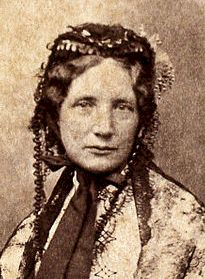|
 |

Part of the American
History & Genealogy Project |
Harriet Beecher Stowe 1811 ~ 1896


Harriet Beecher Stowe
In the little town of Litchfield,
Connecticut, on June 14, 1811, one of the most famous literary
women, Harriet Beecher Stowe, was born. She was the seventh
child of her parents Rev. Lyman Beecher and Roxanna Beecher. Her
father was an eminent divine, but her early childhood days were
filled with the privations of great poverty. When Harriet Stowe
was but five years of age her mother died and she went to live
for a short time with her aunt and grand-mother, until Mr.
Beecher's second marriage.
At twelve years of age she was sent to
the school of Mr. John P. Brace a well-known teacher, where she
soon began to show a great love for composition, and one of her
essays, "Can the Immortality of the Soul be Proved by the
Light of Nature," was considered quite a literary triumph,
and won great admiration from her father who was ignorant of its
authorship. Her sister Catherine went to Hartford, Connecticut,
where her brother was teaching, and decided she would build a
female seminary that women might have equal opportunities with
men. She raised the money and built the Hartford Female
Seminary, and Harriet Beecher at the age of twelve attended her
sister Catherine's school.
She soon became one of the pupil
teachers. Mr. Beecher's fame as a revivalist and brilliant
preacher took him to Boston, but his heart was in the temperance
work and he longed to go West. When called to Ohio to become
president of Lane Theological Seminary at Cincinnati he
accepted, and perhaps we owe to this circumstance Harriet
Beecher Stowe's famous book 'Uncle
Tom's Cabin." In 1836, Harriet married the
Professor of Biblical Criticism and Oriental Literature in that
seminary, Calvin R Stowe. At this time the question of slavery
was uppermost m the minds of Christian people. In 1850 the
Beecher family and 'the Stowes moved to Brunswick, Maine, where
Mr. Stowe had accepted a professorship at Bowdoin College. The
fugitive slave law was in operation and the people of the North
seemed lacking in effort Mrs. Stowe felt she must do something
to arouse the people on this question, and we are told that one
Sunday while sitting in church the picture of Uncle Tom came to
her mind.
When she went home she wrote the chapter
on his death and read it to her two sons, ten and twelve years
of age. This so affected them that they burst into tears. After
two or three more chapters were ready she wrote to Dr. Bailey,
her old friend of Cincinnati days, who had removed his press to
Washington and was editing the National Era in that city. He
accepted her manuscript and it was published as a serial. Mr.
Jewett of Boston feared to undertake the work in book form,
thinking it too long to be popular, but Uncle Tom's Cabin was
published March 20, 1852, as a book. In less than a year over
three hundred thousand copies had been sold. Congratulations
came from crown heads and the literary world. In 1853, when
Professor Stowe and his wife visited England no crowned head was
shown greater honor.
Other books followed from her pen on her
return to America, her husband having taken a position as
Professor of Sacred Literature in the Theological Seminary at
Andover, Massachusetts. Her other works are: "Sunny Memories
of Foreign Lands," "Dread," an anti-slavery story;
'The Minister's Wooing," "Agnes of Sorrento,"
an Italian story; "Pearl of Orr's Island," a New
England coast tale; "Old Town Folks," "House and
Home Papers," "My Wife and I," "Pink and White
Tyranny," but none has added to the fame of her great work,
"Uncle Tom's Cabin." This book has been translated into almost
all the languages. The latter years of Mrs. Stowe's life was
spent between her home among the orange groves of Florida, and
her summer residence in Hartford, Connecticut.
On her seventy-first birthday her
publishers, Houghton Mifflin & Company, gave her a monster
garden party in Newton, Massachusetts, at the home of Governor
Claflin. Poets, artists, statesmen, .and our country's greatest
men and women came to do her honor, and when her life went out
at Hartford, Connecticut, July 1, 1896, we lost one of the
famous women of America.
Women of
America

Source: The Part Taken by Women in
American History, By Mrs. John A. Logan, Published by The Perry-Nalle
Publishing Company, Wilmington, Delaware, 1912.
|